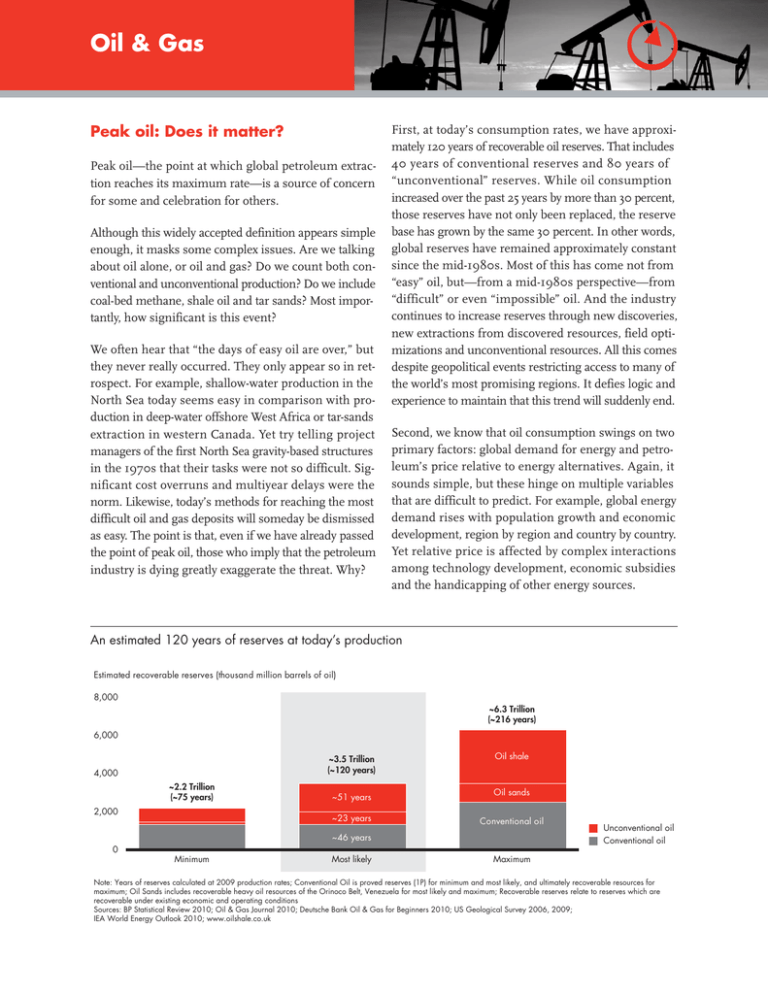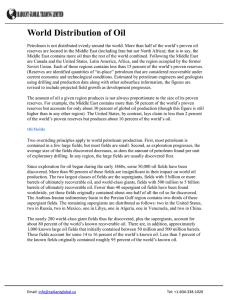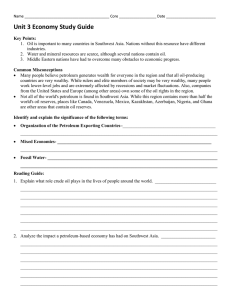Oil & Gas Peak oil: Does it matter?
advertisement

Oil & Gas Peak oil: Does it matter? Peak oil—the point at which global petroleum extraction reaches its maximum rate—is a source of concern for some and celebration for others. Although this widely accepted definition appears simple enough, it masks some complex issues. Are we talking about oil alone, or oil and gas? Do we count both conventional and unconventional production? Do we include coal-bed methane, shale oil and tar sands? Most importantly, how significant is this event? We often hear that “the days of easy oil are over,” but they never really occurred. They only appear so in retrospect. For example, shallow-water production in the North Sea today seems easy in comparison with production in deep-water offshore West Africa or tar-sands extraction in western Canada. Yet try telling project managers of the first North Sea gravity-based structures in the 1970s that their tasks were not so difficult. Significant cost overruns and multiyear delays were the norm. Likewise, today’s methods for reaching the most difficult oil and gas deposits will someday be dismissed as easy. The point is that, even if we have already passed the point of peak oil, those who imply that the petroleum industry is dying greatly exaggerate the threat. Why? First, at today’s consumption rates, we have approximately 120 years of recoverable oil reserves. That includes 40 years of conventional reserves and 80 years of “unconventional” reserves. While oil consumption increased over the past 25 years by more than 30 percent, those reserves have not only been replaced, the reserve base has grown by the same 30 percent. In other words, global reserves have remained approximately constant since the mid-1980s. Most of this has come not from “easy” oil, but—from a mid-1980s perspective—from “difficult” or even “impossible” oil. And the industry continues to increase reserves through new discoveries, new extractions from discovered resources, field optimizations and unconventional resources. All this comes despite geopolitical events restricting access to many of the world’s most promising regions. It defies logic and experience to maintain that this trend will suddenly end. Second, we know that oil consumption swings on two primary factors: global demand for energy and petroleum’s price relative to energy alternatives. Again, it sounds simple, but these hinge on multiple variables that are difficult to predict. For example, global energy demand rises with population growth and economic development, region by region and country by country. Yet relative price is affected by complex interactions among technology development, economic subsidies and the handicapping of other energy sources. An estimated 120 years of reserves at today’s production Estimated recoverable reserves (thousand million barrels of oil) 8,000 ~6.3 Trillion (~216 years) 6,000 4,000 ~2.2 Trillion (~75 years) 2,000 ~3.5 Trillion (~120 years) Oil shale ~51 years Oil sands ~23 years Conventional oil ~46 years 0 Minimum Most likely Unconventional oil Conventional oil Maximum Note: Years of reserves calculated at 2009 production rates; Conventional Oil is proved reserves (1P) for minimum and most likely, and ultimately recoverable resources for maximum; Oil Sands includes recoverable heavy oil resources of the Orinoco Belt, Venezuela for most likely and maximum; Recoverable reserves relate to reserves which are recoverable under existing economic and operating conditions Sources: BP Statistical Review 2010; Oil & Gas Journal 2010; Deutsche Bank Oil & Gas for Beginners 2010; US Geological Survey 2006, 2009; IEA World Energy Outlook 2010; www.oilshale.co.uk Determining how these will develop is impossible, as evidenced by history’s many erroneous predictions of petroleum demand and price. What we can know is that economic growth depends on a reliable supply of energy, provided at the lowest cost. Put another way, it is more useful to identify ongoing energy demand and source trends than the growth rate of new petroleum reserves. In our view, three trends are most important First, new technologies must continue to emerge. That will make production of ever-more difficult petroleum reserves possible and economically feasible, and will reduce the cost of competing energy sources. Environmental concerns will focus technology development on fossil-fuel alternatives. Improved battery technology will eventually provide a better transportation alternative to gasoline power. Wind and water power will grow too, although affected by financial subsidies more than the free market. The main constraint will be human. It requires scientists and engineers to achieve these technological developments. Companies that succeed will be those recruiting, developing and directing qualified personnel in research and technology. Second, flexibility is essential. That means that governments should not constrain any potential energy source. Each will likely be required at some stage. As things sort themselves out, we can expect winners and losers, with varying effects on the pace of countries’ development. Governments that embrace market solutions to energy supply will ensure that their nations are best positioned to develop. They must also monitor scientifically and economically justified environmental developments, maintain stable commercial and fiscal environments in the energy sector, and prioritize the education of young people in the required disciplines. Finally, the petroleum industry will face competition from alternative and potentially subsidized energy sources. The industry must continue to invest in the kind of research and people to develop its own new technologies. The task is not just to find and produce petroleum more effectively. As alternatives develop, the industry must ensure that every petroleum molecule adds the maximum economic value. No one knows how the last barrel of oil produced will be used. Whatever way it plays out, peak oil will occur one day. But it won’t signal the demise of petroleum as a growth enabler. With sufficient investment in technology and people, the industry can look forward to continuing to fuel global economic development for decades to come. Key contacts in Bain & Company’s Global Oil & Gas practice are: Americas: Jorge Leis in Houston (jorge.leis@bain.com); Andy Steinhubl in Houston (andy.steinhubl@bain.com); Jose Sa in São Paolo (jose.sa@bain.com) Europe: Luca Caruso in Moscow (luca.caruso@bain.com); Rob Fisher, Bain Advisor (rob.fisher@bainadvisor.com); John McCreery in London (john.mccreery@bain.com); Roberto Nava in Milan (roberto.nava@bain.com); Peter Parry in London (peter.parry@bain.com); John Smith in London (john.smith@bain.com); Luis Uriza in London (luis.uriza@bain.com) Asia-Pacific: Sharad Apte in Bangkok (sharad.apte@bain.com) Middle East: Christophe de Mahieu in Dubai (christophe.deMahieu@bain.com) For additional information, please visit www.bain.com









